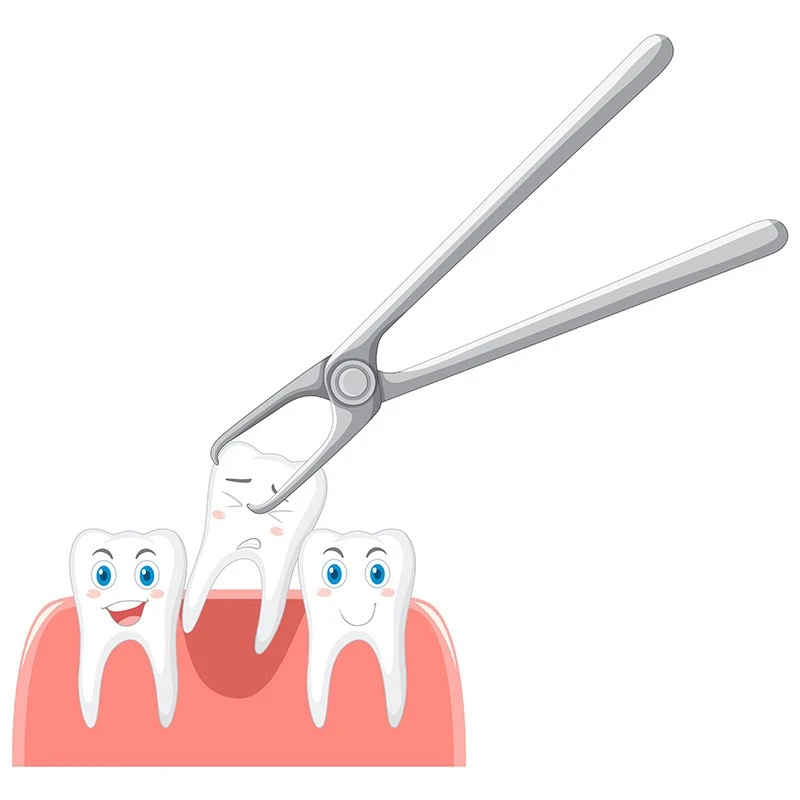Teeth whitening

Tooth extraction
It is a treatment that the dentist will plan as a last resort. Because if the tooth can still be treated with other dental treatments, that treatment method will be chosen first. Because tooth extraction is the permanent loss of natural teeth, and it may cause problems for neighboring teeth to move in a different direction than before if dentures are not worn. There are many reasons why a tooth needs to be extracted, including:
- Tooth decay Severe tooth decay, if not treated for a long period of time, will cause plaque to destroy and reach the tooth nerve cavity. Until it cannot be treated with a filling or root canal. Have a severe toothache, which, if left untreated, may spread to neighboring teeth.
- Gum disease Have a serious problem with gum disease (gum disease) because gingivitis presents with swollen, red gums. If it is in the severe stage, it will cause the bone supporting the teeth to dissolve and the teeth to shift. If not treated properly, the teeth will fall out. or need to have a tooth extracted.
- Broken tooth or accident It makes it necessary to have the tooth extracted. This is because there is so little tooth pulp left that it cannot be fixed with a filling, root canal, or crown.
- Being in a position where you can't get up and if left untreated, it may cause other problems, such as wisdom teeth and implanted teeth.
- Dental care it is preparation before receiving orthodontic treatment. The orthodontist will determine the treatment plan and which teeth will need to be extracted. To create gaps and new tooth alignment It depends on the characteristics of each person's teeth.
Preparation before tooth extraction
- Tooth extraction, or wisdom tooth surgery, is a minor surgery. Patients may eat before coming to the doctor so that when the tooth extraction is complete, they will feel numb. When the numbness goes away, you may feel pain and not want to eat.
- Give your dentist a true and complete health history. Because tooth extraction is a dental treatment that requires local anesthesia, there is also bleeding during and after tooth extraction. The dentist will also prescribe pain relievers and antibiotics. To help relieve pain and inflammation after tooth extraction. Therefore, you should inform the dentist completely.
- If you have congenital diseases such as heart disease, high blood pressure, liver disease, immune system deficiency, etc., or have medicines that are taken regularly, you should inform your dentist. So that the dentist can plan the treatment correctly and safely.
Tooth extraction procedure
- The dentist will examine the mouth and determine the need for tooth extraction. In some cases, it is necessary to take an X-ray. for use in consideration The X-ray can tell the condition of the teeth. The tooth root and bone support the tooth.
- Apply the anesthetic so that the area where the anesthesia will be injected is minimal. and inject anesthetic into the area where the tooth will be extracted.
- When the patient feels completely numb. The dentist will gently shake the tooth little by little. until the tooth falls out.
- After tooth extraction Bite on sterile gauze for 30–60 minutes to stop the bleeding.
- The dentist will provide advice and guidelines regarding care after tooth extraction.
Instructions after tooth extraction
- You should bite firmly on the gauze for about 30–60 minutes to stop the bleeding. And you should change a new cloth afterwards until the bleeding stops.
- Mouthwash should not be used within 6 hours after tooth extraction.
- Do not use your tongue to play with or suck on the wound. It will cause the blood to stop flowing.
- In cases of slight bleeding, you should hold the cold salt water for a while.
- You should not rinse with water within 12 hours after withdrawal.
- You can rinse your mouth with salt water (1 teaspoon of salt and 1 glass of warm water) 12 hours after tooth extraction.
- You can brush your teeth normally, but you should be careful around the wound.
- You should eat soft, cool, and bland foods for the first 2–3 days.
- Avoid drinking alcoholic beverages. and smoking because it will make the wound heal slowly.
- Take painkillers as recommended by your dentist. And use ice for about 15–30 minutes to reduce pain and swelling.
- Pain after withdrawal can be treated with painkillers prescribed by your dentist.

